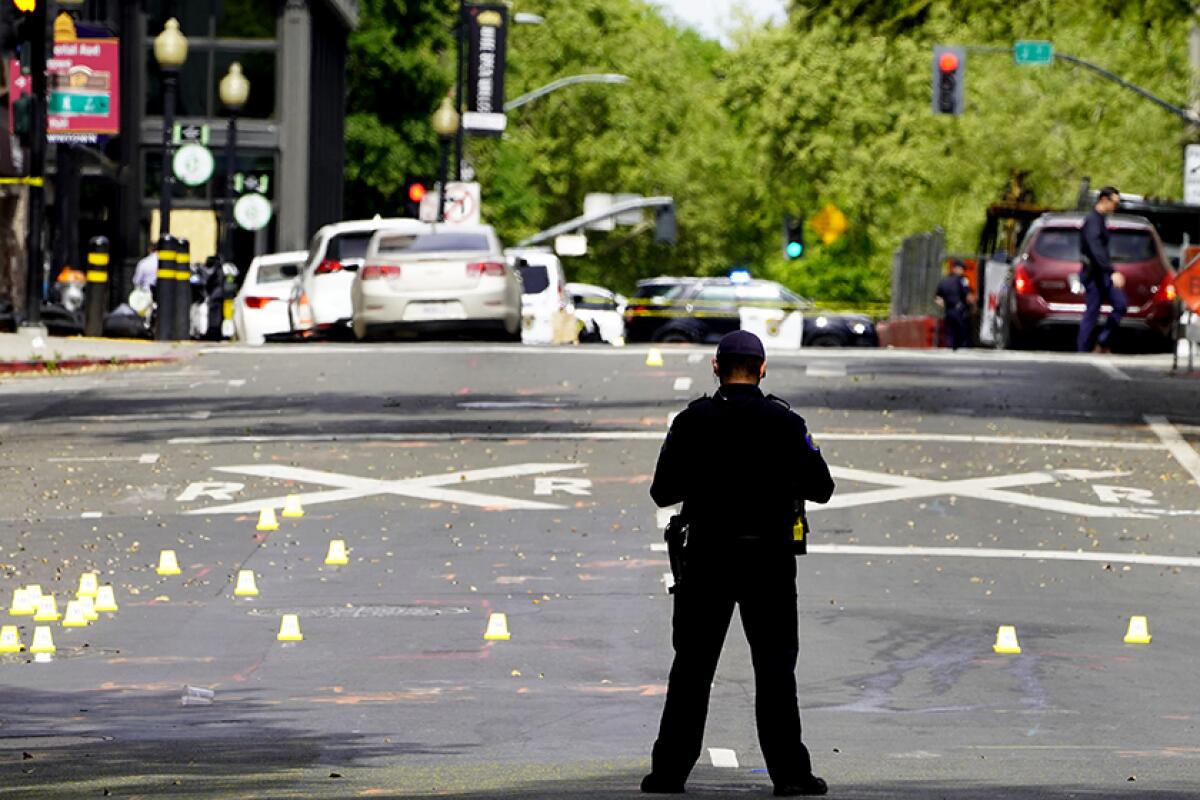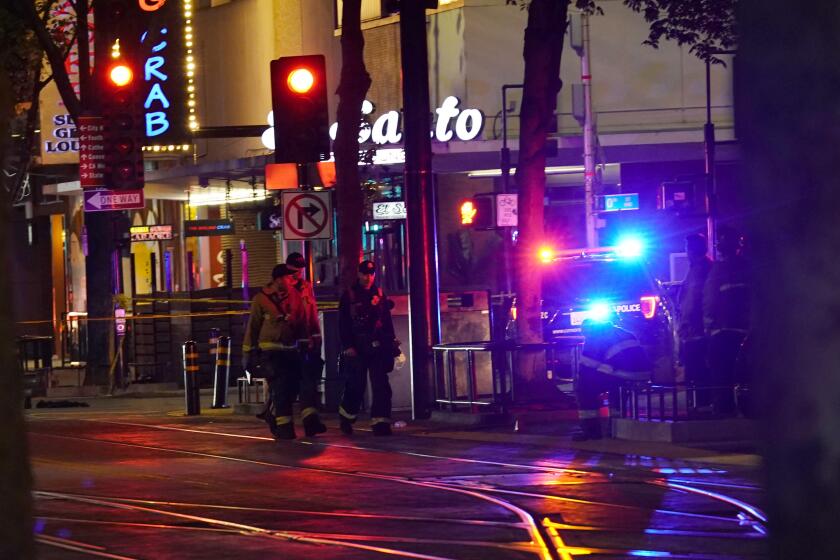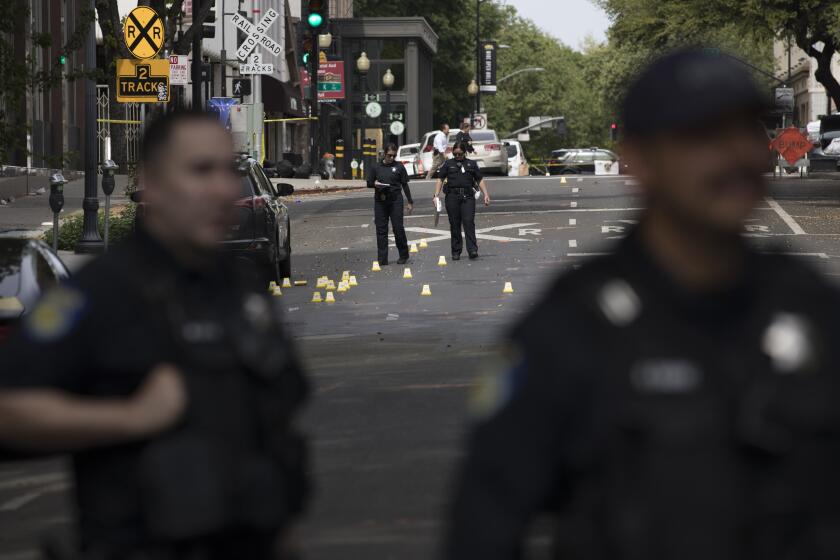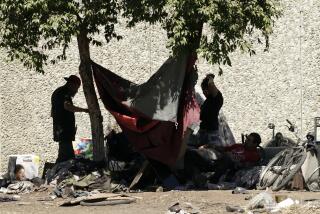Sacramento carnage ‘came out of the blue,’ says gang intervention worker

- Share via
As police, policymakers and family members of victims continued to grapple with a deadly shootout in downtown Sacramento Sunday that left six dead and 12 injured, gang intervention experts in the city said the explosion of violence appeared to have sprung up with little warning.
“I was just astonished,” said Julius Thibodeaux, who works with the group Movement for Life, which runs a “boots on the ground” operation with the city’s gang members. The group makes it a point to know what is happening in the city’s troubled neighborhoods, the better to try to stop violence before it erupts. But Thibodeaux said when he got the news at 3 a.m. Sunday about the carnage that unfolded outside downtown nightclubs just blocks from the state capital, it came “out of the blue.”
After initially saying the deadly incident involved a man firing from a car as bar patrons streamed onto 10th Street, Sacramento police on Wednesday said that at least five people drew weapons and began firing into the crowd. The dead included three fathers, two young women out for a night on the town and a homeless woman who often slept in the neighborhood and chatted with local business owners.
In a statement, police said it was “increasingly clear that gang violence is at the center of this tragedy.” Police have not named the gangs they believe were involved or given a motive for the hail of gunfire.
Only one alleged shooter has been named, 26-year-old Dandrae Martin. So far, however, he has only been charged with being a felon in possession of a gun.
Sacramento police said Thursday, in an update posted on Twitter, that they continue to work through a mountain of evidence in the case, including 200 videos submitted by the public, as well as interviews with witnesses. They also said the shell casings found at the scene, which numbered more than 100, had been “submitted to a national database for evidentiary review.”
Authorities don’t have a firm motive in the Sacramento massacre. But it’s clear now the shooting was the result of a conflict among groups of people.
People who work on Sacramento’s streets with gang members and troubled youth, meanwhile, said they were struggling to understand what had happened, and that they had put interventions in place to forestall further bloodshed. Some questioned the police characterization of the crime as gang-related.
“You had one active gang group, the Crips,” said Mervin Brookins, who co-founded Brother 2 Brother, a violence intervention program in the neighborhood where one of the victims came from. “And you had some older guys that used to be Bloods,” he said. “It wasn’t motivated by one gang having beef with the other gang.”
He said he believes it is more likely that two groups of men had a conflict that escalated, and their current or former gang affiliations may have been incidental.
Thibodeaux, the intervention worker with Movement for Life, said his group had been planning for the summer, when more gun violence typically flares up because kids are out of school and everyone spends more time in warm weather in local parks and gathering spots.
“We actually thought we were going to get out ahead of the violence this summer,” he said.
But he added that programs like his have taken a beating during the pandemic, because of a variety of factors. Closed schools left youth with more time on their hands; mentors were not able to meet with their charges; close quarters during lockdown led to short tempers.
Before the pandemic, he points out, Sacramento went 28 months without a minor being killed. Now, he said, there is a need to “double down” on community aid programs to reach at-risk boys and men.
“Everyone benefits from public safety,” he said. “I’m not thinking we can police our way out of this.”
Berry Accius, a community activist who runs a nonprofit that works with youth, agreed.
”How is it that young people can find a gun quicker than they can find an opportunity?” he asked. “If we invest in these young people now, they become better adults for tomorrow.”
Sacramento police say there were at least five shooters but are not providing details if any suspects are still at large.
It was a theme that Sacramento Mayor Darrell Steinberg and other progressives also sounded this week, calling on Gov. Gavin Newsom to spend $3 billion on crime prevention and other services.
But — chiming in from the other side of California’s contentious battle over criminal justice reform — many Republicans and law enforcement advocates held a news conference Thursday to argue that what is really needed is stiffer sentences for gun and gang crimes and an end to early release from prison.
As the debate rages, both camps will have to wait for more information from investigators about what happened.
Police have so far arrested three people, but none of them have been charged with murder, or even with firing weapons on Sunday.
Police say that 27-year-old Smiley Martin III — the brother of Dandrae Martin — had a gun at the scene, but he has yet to be charged. He will be booked at Sacramento County Main Jail on suspicion of “possession of a firearm by a prohibitive person and possession of a machine gun” as soon as he gets out of the hospital. Smiley Martin was shot during the barrage. Police and court records show he has a lengthy violent crime record stretching back nearly a decade. He is affiliated with the Crips gang, according to his social media posts.
Another man, Daviyonne Dawson, 31, was arrested after being spotted carrying a gun in the aftermath of the shooting, but did not actually fire it. Dawson is not accused of involvement in the melee.
Police have also declined to say whether they believe any of the dead were among the shooters.
Dist. Atty. Anne Marie Schubert told a local television station that her office’s major crimes unit has the case and is “obviously working very extensively with the Sacramento Police Department” to provide them with resources and keep current on developments in the complicated case so when it comes time to file charges on multiple suspects her team will “have everything we need.”
Legal experts said it should come as no surprise that prosecutors haven’t yet filed murder charges.
Evidence has emerged that Sunday’s incident resulted from a gang feud involving Crips and Bloods that escalated into gunfire.
Prosecutors may believe they know who the shooters are, said former Los Angeles County prosecutor Alan Jackson.
“You may even know beyond any reasonable doubt that you’ve got the right person, but you haven’t crossed every T and dotted every I,” Jackson said. “You haven’t served every subpoena. You haven’t executed every search warrant. You haven’t gathered every single piece of evidence that you possibly can to make the case of filing bulletproof.”
In the meantime, he said, prosecutors may keep suspects locked up on lesser charges.
As the city waits for further legal developments, community activist Leia Schenk, who is working with three of the families who lost loved ones, said that despite the criminal histories of some who appear to be involved, she said she doesn’t believe the focus should be on gangs, but on the victims.
“Right now, I am so focused on maintaining the humanity of the lives behind these folks,” she said. “Yes, gangs are an issue, but whether this was gang-related or not … these were sons, daughters. A lot of these folks had children.”
More to Read
Sign up for Essential California
The most important California stories and recommendations in your inbox every morning.
You may occasionally receive promotional content from the Los Angeles Times.

















